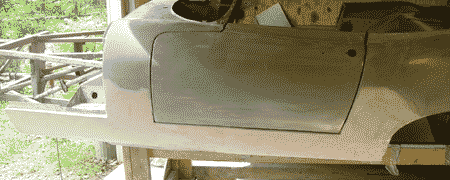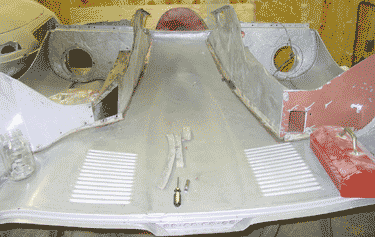
1963 Jaguar E-Type OTS
The story of a ground up restoration of a classic "XKE" Jaguar roadsterLeft Outer Sill, Bonnet Internals Fitted (04 - 16 July 2003)
|
|
|
|
|
|
|
| Time has been split this summer between the garden (which is quite abundant this year), a wood floor we've been installing, and the old Jaguar.
Progress has been slower than I'd hoped, but I guess that's always the case. This September we're coming up on the anniversary of picking
up the car, and I'm interested to see where we are after a year.
Left Outer Sill
We completed the installation of the left outer sill — the one that I fabricated. As I mentioned, we had to use about two millimeters
thickness of body filler along the top of the sill where it abutts the bottom edge of the door. I realize now that I could have avoided this
Now that I've nearly finished the body filler smoothing, I look back and think that those Martin Robey sills are a pretty good deal. Not only do they fit nicely, but you don't have to mess with Bondo (except for the occassional dent or ding). I haven't looked at the price I paid for the right outer sill, but I think it would have been worth the time to get a left outer sill from Martin Robey, too. What's the old bromide? Penny wise, pound foolish. Aaron wasn't too enthusiastic about doing the line of welds where the sill meets the floor panel — really under the car. He had done these welds on the other sill and was dodging hot metal droplets the entire time. I did the low welds, and it was not fun. I guess that rotisserie looks better all the time. But we are actually very near the point when such a thing isn't useful. We put the door on just to make sure that the door panel fit the frame perfectly, and the side really looks pretty good. It's nice to see that the car is just now beginning to go back together into a recognizable shape. Bonnet Internals Fitted (Almost)
Inside the bonnet are several parts that have the roles of supporting the outer shell and of directing air to the heater fan and to the air
intake for the engine. The "default" course of air through the bonnet mouth, as it were, goes to the radiator for cooling the engine —
something the early E-types were not known to do very efficently. (Our E-type had a contraption that was intended to assist cooling,
There are two walls that sit astride the engine and that have ducts going from the sides of the bonnet mouth to the air intake and the heater fan. These were damaged in the front, and I had to bang the wrinkles out and clip off some extra metal. Because I fashioned larger tabs at the front of the bonnet, I had to cut out a deeper slit where these parts fit against the front of the bonnet. These parts are very putzy to fit. The walls don't fit as well as I had expected. They are farther from the center section of the bonnet than I had hoped. Since this fitting has been done with the bonnet upside down (as pictured), I'm going to right the bonnet and then take a look at how the internal walls fit. It could be that the dynamics of the piece will change with the pull of gravity working in the intended way.
|
 additional body filler had I not been so intent on pushing the sill under the lip of the door frame (which is actually the upper section of
the inner sill. I wanted to make sure that there was adequate metal to weld into, which was actually not a problem. Well, next time I won't
make the same mistake.
additional body filler had I not been so intent on pushing the sill under the lip of the door frame (which is actually the upper section of
the inner sill. I wanted to make sure that there was adequate metal to weld into, which was actually not a problem. Well, next time I won't
make the same mistake.
 though it probably had the actual effect of decreasing the air flow to the radiator.) There are seven major parts of this internal structure, with
some smaller, tab-like parts that are glued to the inside of the bonnet's center section. Very early E-types had these tabs welded to the section,
often resulting in visible dent-like spots along the top of the bonnet to each side of the "performance bulge" in the center. Not too long
into the production of the E-type, these tabs were glued — use of adhesives for this purpose was quite new in automobile manufacture,
as a matter of fact.
though it probably had the actual effect of decreasing the air flow to the radiator.) There are seven major parts of this internal structure, with
some smaller, tab-like parts that are glued to the inside of the bonnet's center section. Very early E-types had these tabs welded to the section,
often resulting in visible dent-like spots along the top of the bonnet to each side of the "performance bulge" in the center. Not too long
into the production of the E-type, these tabs were glued — use of adhesives for this purpose was quite new in automobile manufacture,
as a matter of fact.